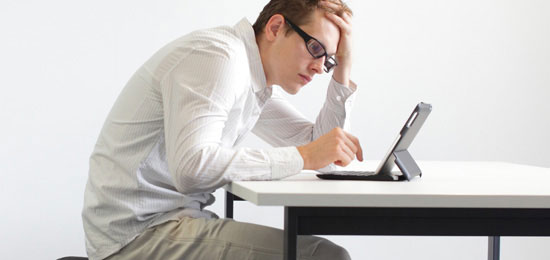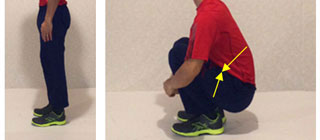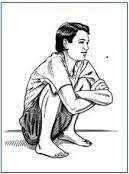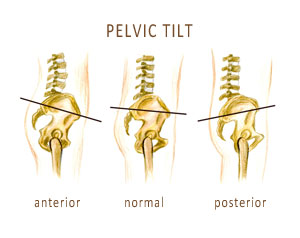
Chronic slouching at the desk can cause painful muscle imbalances
Is Your Back Pain From Adaptive Shortening Syndrome?
Chances are you have it. Here is how to stop it.
Sherwin Nicholson | Updated May 8, 2020
It’s what will make you feel like you’ve aged 30 years! (scroll down to take the test)
Did you know that just by sitting motionless, you’ll cause your back to become worse? What doesn’t hurt now, in time will catch up with you.
If you often sit motionless (office, driving, screens) for hours at a time and have lower back problems, chances are you have adaptive shortening, and it is causing a great deal of pain.
It may not feel uncomfortable at first, but as you continue to remain seated, a dull ache develops and your body begins to become stiffer and increasingly uncomfortable. As you move to compensate, it begins to hurt even more.
Sometimes you may even feel as if you are locked up in a fixed position while seated. Adaptive shortening can make you feel this way. It’s preventable and there is something that you can do to reverse it.
The irony of it all is that you are probably contributing to it right now as you search online for help! So be careful as you search this site for support (take many breaks to stand up and move around and do the seated lunge move).
It’s certainly something that I must always stay aware of in order to keep my own spine healthy. Writing articles, especially really long ones are bad for your spine. So I am always making sure that I protect myself by committing to my exercises and spending enough time away from the chair.
Get immediate help here if you have pain from sitting at the office all day.
What is adaptive shortening and why does it matter?
It matters because it can occur to any muscle group, but it is very common with lower back pain. This happens because all of those muscles and the connective tissue along your spine that are helping you to maintain your posture have become severely imbalanced in length, strength, tension and activity.
You have muscle imbalances, really!
This imbalance typically causes a chronic shortening and weakening of muscles one side of your spine, the smaller muscles of your back, abdominals and hip flexor muscles.
It takes a long time to reach this level of discomfort (months to years) and you don’t really notice that it’s happening at all because your body is pretty tolerant to some point. But sooner or later, your joints and nerves will let you know. And because of all of the atrophy that has been going on, it’s going to take you some time to get over this syndrome.
Your spine can change it’s curve with increasingly poor posture
If you continue to sit with poor posture, it causes the natural (balanced) S-shaped curve of your spine to become C-shaped. With adaptive shortening, you tend to develop poorer posture and more pain. It also causes the spine to become stiffer and less flexible where the muscles have shortened.
Here is an easy way to tell you have shortening:
A simple way that to tell that you have it, is when it becomes increasingly difficult to straighten up as you stand. It can also be very uncomfortable to do so. You tend to rely on using your arms to raise up as support. You’re also slow at it!
A painful cycle of shortening and weakness
Your body normally tries to keep the spine balanced on both sides by providing equal, muscular support. Adaptive shortening prevents this from happening. It’s because opposing antagonistic muscles which are supposed to balance the other side of your spine end up straining, which leads to excessive lengthening. This lengthening is what allows the cycle of shortening to continue.
In addition, as you sit, your glutes (butt muscles) are becoming weaker and weaker, making it even harder for you to raise yourself.
If you are finding it more and more difficult to straighten up after sitting, this is why.
Too much time spent sitting in such a compromised way keeps this painful cycle active.
Most of the working population in their 30’s and older that must sit or maintain such a compromised posture are affected. Office workers and drivers are most susceptible along with couch potatoes.
Unfortunately, some of us are guilty of practicing all three activities with little opportunity in between to correct this posture.
A recipe for disaster to avoid
The imbalance from this syndrome is a recipe for serious long term injury. Because we often neglect or even abuse ourselves with excessive sitting, we set ourselves up for this condition. Worse yet, we rarely find the opportunity to correct the situation because we don’t make it a priority.

Because we can’t see what is happening to our muscles and supportive, connective tissue, we don’t think it’s severe as it is until something more painful occurs such as a spasm, disc herniation or muscle sprain.
Are you a weekend warrior? Then beware of potential injury.
A good example is the weekend warrior that has a sudden back issue. When they have spent most of their work week seated in this position, they then become highly active on the weekend and suddenly their back goes out with a full spasm. The added strain of taking a chronically shortened muscle and forcing it to lengthen so quickly causes both risk of disc and muscle injury.
The added strain of taking a chronically shortened, weakened and very inactive muscle and forcing it to quickly function normally causes a major risk of disc and muscle injury.
Don’t allow this condition to become the norm for you
What it so profoundly odd about this condition is that you tend to prefer this slouched posture more than you would like to stand (or at least sit straighter). Standing causes these shortened muscles to fatigue when straightened and you prefer to rest instead into this compromised position.
If you are exercising too much or actively moving with shortened muscles, they will tire and cause pain. Use caution as you may mistakenly continue exercising with these symptoms while they may feel manageable.
Surefire clues that you have adaptive shortening

- You struggle to stand up straight after sitting for a long time. Your motions are similar to a much older senior getting up very slowly due to aging.
- Your posture becomes progressively compromised, simulating the appearance of someone with that of a slouched posture or hunch rather than standing perfectly upright as you used to.
- Symptoms of stiffness and aches are common. They do diminish over time but end up returning whenever you resume your way of sitting.
- You have a persistent dull ache and arching your body brings some slight relief.
- You are constantly moving in your chair. This is because you are noticing the pull of these tight areas and are looking for a better position to avoid feeling it.
- You work in any office type setting and don’t spend any time moving around.
Why it takes time to correct
It becomes harder to transition out of this posture without adequate help because both sets of muscles as mentioned are not only short but weak.
These muscles have shrunken and lost their flexibility. They are very slow to lengthen on command such as moving from a sitting or crouched position to standing.
The same effect happens when moving down to a crouched position from standing.
Another way to test yourself

The Deep Squat Rest is a test exercise which I demonstrate in the eBook to prove another example of adaptive shortening.
Not only can you experience shortening from sitting too long, but also from standing too long as your hips and lower back tightens up.
Try this squat below to see if you have shortening that leads to pain.
You might notice the following issues:
- Cannot squat down low with feet flat on the floor
- Can squat almost all the way but need to raise your heels
- Falling forward or backwards while trying to squat
- Hip and lower back is sore in this position
- Need to use your arms to lift yourself out of this position
- Can squat but not able to bring your stomach up against your thighs
Most of us should be able to squat deeply, but because of shortening, these imbalances cause an otherwise stable and flexible person to fall over or feel uncomfortable when trying this exercise initially.
If you can’t get into a deep squat, it is because supportive lower lumbar spine, hip and leg muscles have shortened. The chances are that if you have visited this site, you will find this test difficult to perform.

Deep squatting is a seated posture that many cultures around the world practice simply as a comfortable way to sit. It is encouraged from a very early age and practiced well into the senior years. Western or European culture rarely adopts this posture.
However, where we all witness deep squatting is with our very young toddlers.
They can both quickly sit down into and raise on up, out of this position with ease.
When you watch a toddler explore and play, you can see that they will actually prefer to squat down this way using only the strength of their legs to lower and raise themselves. They rarely use their hands for support.
Adults, those especially with lumbar pain will find this very challenging to perform unassisted and as quickly as a toddler can.
Ideally, we should be practicing this type of movement as it helps to correct this form of shortening.
The goal of the exercise is to demonstrate where your imbalances have affected your posture and what you should be able to do once it is corrected.
What you can do about it
Correcting this imbalance takes time and is not solved overnight. Many areas require reconditioning over time.
What is your tilt?
To begin re-balancing, you will need to determine if your pelvic tilt is either neutral, anterior or posterior. How you sit and your body weight can affect your tilt. Hip flexor and quadricep stretches can help to correct and excessive anterior pelvic tilt while hamstrings stretches will help to correct a posterior tilt.

It is essential to sit using the posture of a neutral S-curve while relying as little as possible on using your chairs’ lumbar support. Although this will not fully correct shortening, it is an easy way to begin to reverse your imbalances.
By focusing on these corrections with an exercise plan, you will be able to stabilize and protect yourself during prolonged sitting. The bottom line is much less pain, soft tissue damage, and improved mobility.
The bottom line is much less pain, soft tissue damage, and improved mobility.
You will be all the better for it and will be able to sit safer and without the same discomfort as before.
Test yourself while learning to correct it here. Begin with the Deep Squat Rest, and you will notice the difference for yourself.
If you liked this article, you’ll also like:
When Your Back Hurts at the Office
Help for Your Tight Hip Flexors
References:

